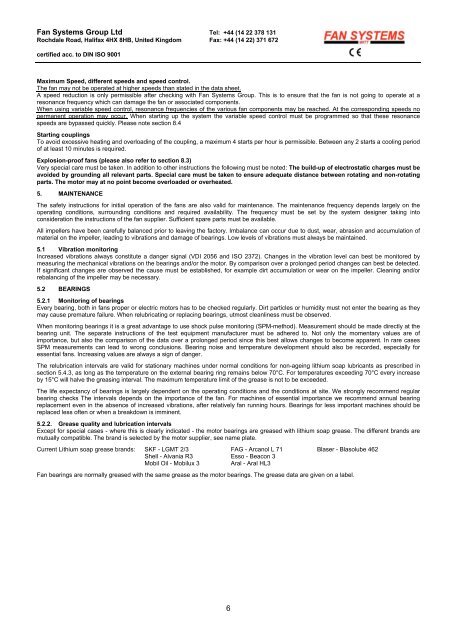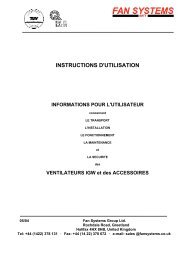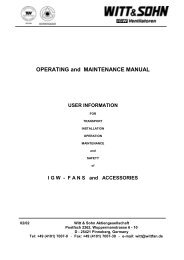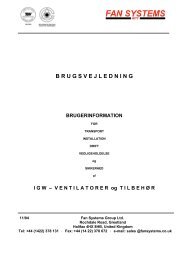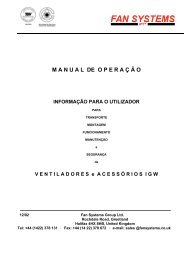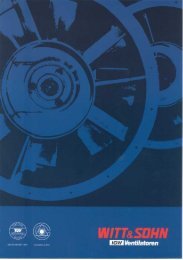OPERATING and MAINTENANCE MANUAL Jetfans and other Axial ...
OPERATING and MAINTENANCE MANUAL Jetfans and other Axial ...
OPERATING and MAINTENANCE MANUAL Jetfans and other Axial ...
Create successful ePaper yourself
Turn your PDF publications into a flip-book with our unique Google optimized e-Paper software.
Fan Systems Group Ltd Tel: +44 (14 22 378 131Rochdale Road, Halifax 4HX 8HB, United Kingdom Fax: +44 (14 22) 371 672certified acc. to DIN ISO 9001Maximum Speed, different speeds <strong>and</strong> speed control.The fan may not be operated at higher speeds than stated in the data sheet.A speed reduction is only permissible after checking with Fan Systems Group. This is to ensure that the fan is not going to operate at aresonance frequency which can damage the fan or associated components.When using variable speed control, resonance frequencies of the various fan components may be reached. At the corresponding speeds nopermanent operation may occur. When starting up the system the variable speed control must be programmed so that these resonancespeeds are bypassed quickly. Please note section 8.4Starting couplingsTo avoid excessive heating <strong>and</strong> overloading of the coupling, a maximum 4 starts per hour is permissible. Between any 2 starts a cooling periodof at least 10 minutes is required.Explosion-proof fans (please also refer to section 8.3)Very special care must be taken. In addition to <strong>other</strong> instructions the following must be noted: The build-up of electrostatic charges must beavoided by grounding all relevant parts. Special care must be taken to ensure adequate distance between rotating <strong>and</strong> non-rotatingparts. The motor may at no point become overloaded or overheated.5. <strong>MAINTENANCE</strong>The safety instructions for initial operation of the fans are also valid for maintenance. The maintenance frequency depends largely on theoperating conditions, surrounding conditions <strong>and</strong> required availability. The frequency must be set by the system designer taking intoconsideration the instructions of the fan supplier. Sufficient spare parts must be available.All impellers have been carefully balanced prior to leaving the factory. Imbalance can occur due to dust, wear, abrasion <strong>and</strong> accumulation ofmaterial on the impeller, leading to vibrations <strong>and</strong> damage of bearings. Low levels of vibrations must always be maintained.5.1 Vibration monitoringIncreased vibrations always constitute a danger signal (VDI 2056 <strong>and</strong> ISO 2372). Changes in the vibration level can best be monitored bymeasuring the mechanical vibrations on the bearings <strong>and</strong>/or the motor. By comparison over a prolonged period changes can best be detected.If significant changes are observed the cause must be established, for example dirt accumulation or wear on the impeller. Cleaning <strong>and</strong>/orrebalancing of the impeller may be necessary.5.2 BEARINGS5.2.1 Monitoring of bearingsEvery bearing, both in fans proper or electric motors has to be checked regularly. Dirt particles or humidity must not enter the bearing as theymay cause premature failure. When relubricating or replacing bearings, utmost cleanliness must be observed.When monitoring bearings it is a great advantage to use shock pulse monitoring (SPM-method). Measurement should be made directly at thebearing unit. The separate instructions of the test equipment manufacturer must be adhered to. Not only the momentary values are ofimportance, but also the comparison of the data over a prolonged period since this best allows changes to become apparent. In rare casesSPM measurements can lead to wrong conclusions. Bearing noise <strong>and</strong> temperature development should also be recorded, especially foressential fans. Increasing values are always a sign of danger.The relubrication intervals are valid for stationary machines under normal conditions for non-ageing lithium soap lubricants as prescribed insection 5.4.3, as long as the temperature on the external bearing ring remains below 70°C. For temperatures exceeding 70°C every increaseby 15°C will halve the greasing interval. The maximum temperature limit of the grease is not to be exceeded.The life expectancy of bearings is largely dependent on the operating conditions <strong>and</strong> the conditions at site. We strongly recommend regularbearing checks The intervals depends on the importance of the fan. For machines of essential importance we recommend annual bearingreplacement even in the absence of increased vibrations, after relatively fan running hours. Bearings for less important machines should bereplaced less often or when a breakdown is imminent.5.2.2. Grease quality <strong>and</strong> lubrication intervalsExcept for special cases - where this is clearly indicated - the motor bearings are greased with lithium soap grease. The different br<strong>and</strong>s aremutually compatible. The br<strong>and</strong> is selected by the motor supplier, see name plate.Current Lithium soap grease br<strong>and</strong>s: SKF - LGMT 2/3 FAG - Arcanol L 71 Blaser - Blasolube 462Shell - Alvania R3 Esso - Beacon 3Mobil Oil - Mobilux 3Aral - Aral HL3Fan bearings are normally greased with the same grease as the motor bearings. The grease data are given on a label.6


